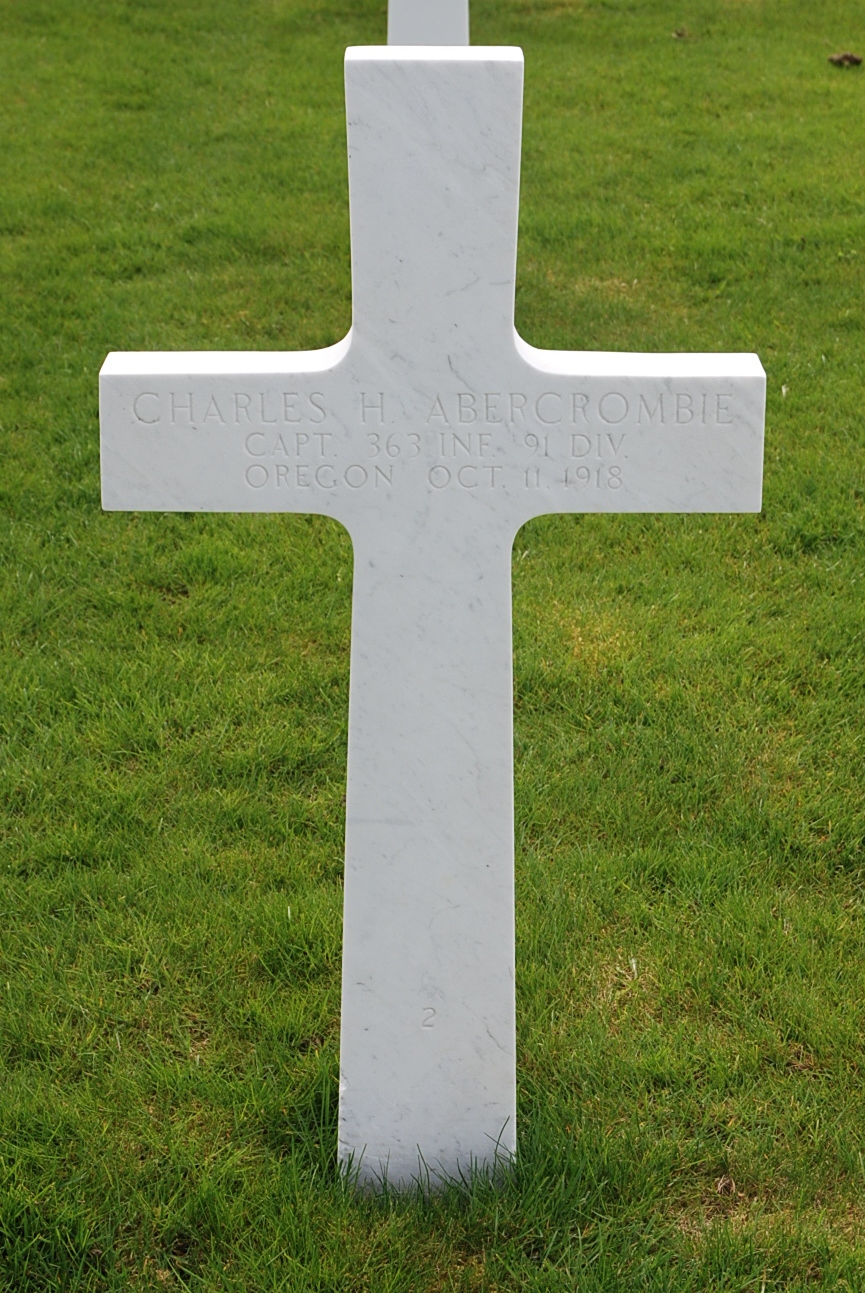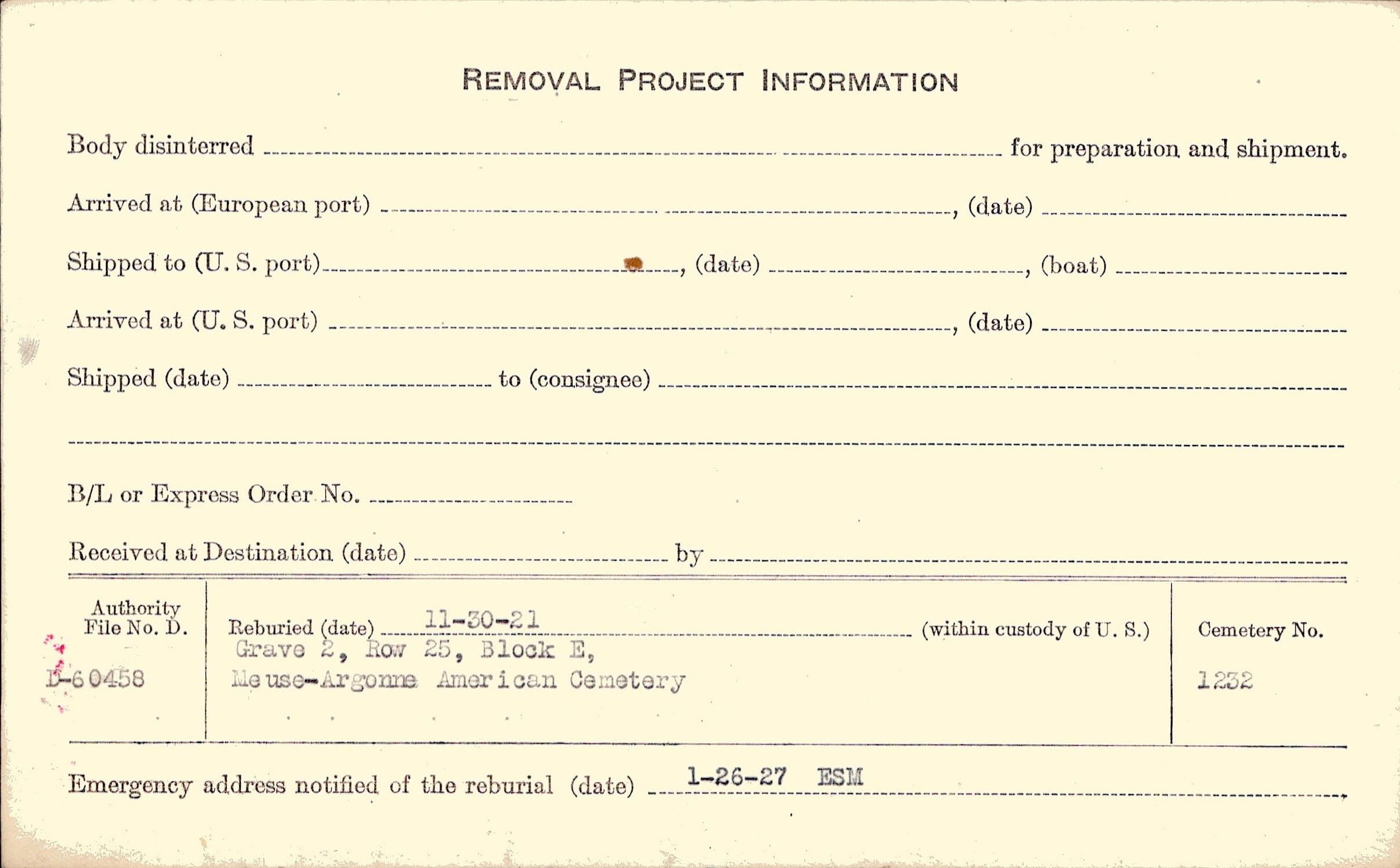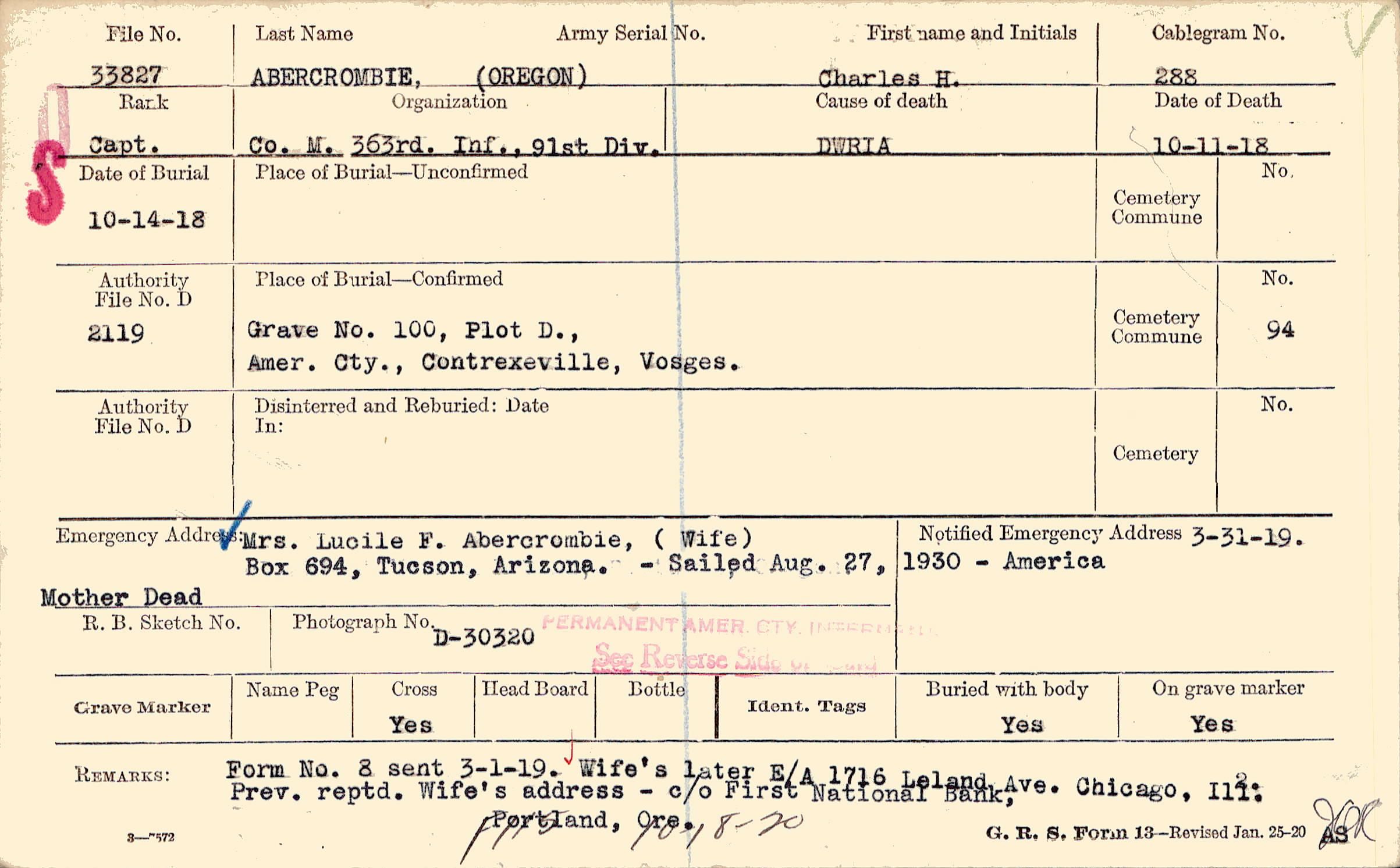Jan. 18, 1920; Oregonian
Charles H. Abercrombie, captain of company M, 363d infantry. He was a Portland lawyer, the attorney for the Security Savings & Trust company. He had a wife and three children, and he was of an age at which few volunteered, yet he was among the first to go into training, and when the great 91st division went overseas. Abercrombie was with it as an infantry leader.
It was mid-July when he got to France, and in less than two months he was on his way to the front. September 26, at daybreak, he took company M over the top from a point near Chigallerie butte, on the north side of the Foret de Hesse, and proceeded through the western edge of the Bois de Cheppy toward the village of Very. Captain Abercrombie's company was part of a support battalion on the first day, and accordingly had few losses.
On September 27, however, company M was in the front wave, and in traversing the bullet and shell-swept plateau between Very and Eclisfontaine had no fewer than 13 men killed or fatally wounded, of whom one was the redoubtable captain.
It was about 4 P.M. before the captain was struck. His men had advanced about two kilometers since the morning. The captain himself had got across the national highway running through Varennes, Eclisfontaine and Romagne. Sergeants Pedrioli and Thompson, Corporals Powell and Nonnenmann and Privates Tucker, Kicker, Blair, Gallagher, Eide and Wainio, all company M. men, were already dead or dying, while many a man had fallen with lesser wounds among the shell holes or in the barb wire. A few hundred yards to the left rear, the 35th division (Missouri and Kansas) was trying to struggle forward. The 35th was a little behind, and, although company M did not know it, 91st headquarters was soon to stop men from going farther till the line could be straightened out.
Then a shell fell close to the captain. James Hammill, a private, had an eye blown out. His captain was struck in the legs, and the right leg was nearly torn off. The boys gathered around him and discussed getting him back to Very. He was an immense man, and it was nearly two miles to the dressing station. Sixteen of his men took turns in carrying him back.
Twice on the way he asked the boys to take their knives and cut off the worst injured leg, but it was not done. Soldiers were always chary of doing surgical work. "I think I'll lose both my legs," he said at one time. He asked once for water. One of the boys remarked that they had the Huns running, and he said: "That's good." One officer who talked with him soon after he had been struck was F. S. Sever of Portland, commander of company L. Another was Major Cadwalter. Soon after the sorrowful procession started toward Very, a shell came so close that the captain put his hands over his face to keep off the debris.
He reached the dressing station in Very canyon about two hours after he was hit. He was sent through the evacuation hospitals in the Aire river valley, a dozen miles southeast, and on October 3 reached base hospital No. 31 at Contrexeville, Vosges. The right leg had been amputated in the Aire river valley.
From Contrexeville, Captain Abercrombie twice wrote to his wife, Mrs. Lucile Abercrombie, then in Chicago, now living in Portland. He wrote that his fighting days were over, but that he thought Uncle Sam would hurry the wounded home, and that he might get there by Christmas.
A chaplain prayed with him on October 10. On the 11th he died.
Meanwhile the little family expected him home for Christmas. It was its practice to hurry to the door when the bell rang in hope that he might be there.
As Christmas dinner was being prepared the bell rang again. The mailman was there.
What he handed in was a letter from the chaplain announcing Captain Abercrombie's death.
Jan. 18, 1920; Oregonian
Charles H. Abercrombie, captain of company M, 363d infantry. He was a Portland lawyer, the attorney for the Security Savings & Trust company. He had a wife and three children, and he was of an age at which few volunteered, yet he was among the first to go into training, and when the great 91st division went overseas. Abercrombie was with it as an infantry leader.
It was mid-July when he got to France, and in less than two months he was on his way to the front. September 26, at daybreak, he took company M over the top from a point near Chigallerie butte, on the north side of the Foret de Hesse, and proceeded through the western edge of the Bois de Cheppy toward the village of Very. Captain Abercrombie's company was part of a support battalion on the first day, and accordingly had few losses.
On September 27, however, company M was in the front wave, and in traversing the bullet and shell-swept plateau between Very and Eclisfontaine had no fewer than 13 men killed or fatally wounded, of whom one was the redoubtable captain.
It was about 4 P.M. before the captain was struck. His men had advanced about two kilometers since the morning. The captain himself had got across the national highway running through Varennes, Eclisfontaine and Romagne. Sergeants Pedrioli and Thompson, Corporals Powell and Nonnenmann and Privates Tucker, Kicker, Blair, Gallagher, Eide and Wainio, all company M. men, were already dead or dying, while many a man had fallen with lesser wounds among the shell holes or in the barb wire. A few hundred yards to the left rear, the 35th division (Missouri and Kansas) was trying to struggle forward. The 35th was a little behind, and, although company M did not know it, 91st headquarters was soon to stop men from going farther till the line could be straightened out.
Then a shell fell close to the captain. James Hammill, a private, had an eye blown out. His captain was struck in the legs, and the right leg was nearly torn off. The boys gathered around him and discussed getting him back to Very. He was an immense man, and it was nearly two miles to the dressing station. Sixteen of his men took turns in carrying him back.
Twice on the way he asked the boys to take their knives and cut off the worst injured leg, but it was not done. Soldiers were always chary of doing surgical work. "I think I'll lose both my legs," he said at one time. He asked once for water. One of the boys remarked that they had the Huns running, and he said: "That's good." One officer who talked with him soon after he had been struck was F. S. Sever of Portland, commander of company L. Another was Major Cadwalter. Soon after the sorrowful procession started toward Very, a shell came so close that the captain put his hands over his face to keep off the debris.
He reached the dressing station in Very canyon about two hours after he was hit. He was sent through the evacuation hospitals in the Aire river valley, a dozen miles southeast, and on October 3 reached base hospital No. 31 at Contrexeville, Vosges. The right leg had been amputated in the Aire river valley.
From Contrexeville, Captain Abercrombie twice wrote to his wife, Mrs. Lucile Abercrombie, then in Chicago, now living in Portland. He wrote that his fighting days were over, but that he thought Uncle Sam would hurry the wounded home, and that he might get there by Christmas.
A chaplain prayed with him on October 10. On the 11th he died.
Meanwhile the little family expected him home for Christmas. It was its practice to hurry to the door when the bell rang in hope that he might be there.
As Christmas dinner was being prepared the bell rang again. The mailman was there.
What he handed in was a letter from the chaplain announcing Captain Abercrombie's death.
Inscription
CAPT. 363 INF. 91 DIV.
OREGON OCT 11 1918








